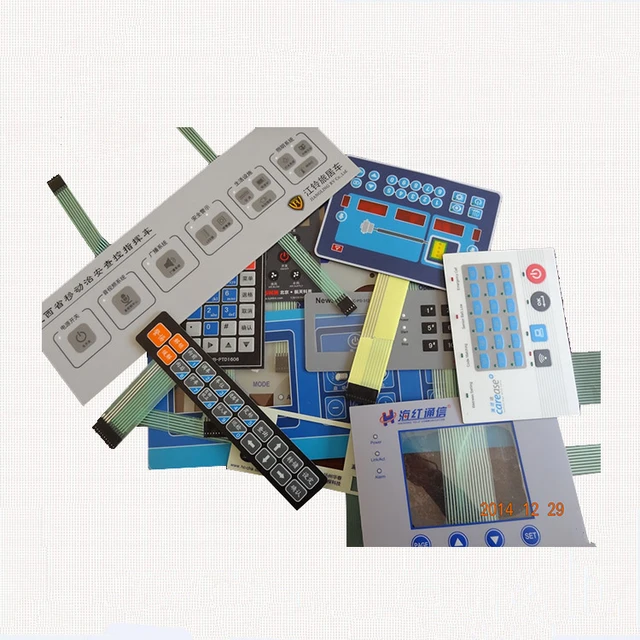Innovative Membrane Switch Solutions for Customized Control Panels
Innovative Membrane Switch Solutions for Customized Control Panels
Blog Article
Recognizing Membrane Layer Switches: The Key to Durable and Trusted Controls

What Are Membrane Switches?
Membrane layer buttons are a sophisticated solution in the world of interface modern technology, integrating functionality and layout perfectly. These tools act as an interface in between users and electronic systems, incorporating a number of elements right into a portable layout. Typically constructed from adaptable, slim layers of materials, membrane layer switches are designed to react to touch, making it possible for users to connect with machinery and electronic gadgets successfully.
The main aspects of a membrane layer button include a printed circuit layer, graphic overlay, and a spacer layer that protects against unplanned activation. The graphic overlay can be personalized to mirror brand name identity or individual choices, boosting looks while ensuring use. Membrane switches are typically used in various applications, consisting of clinical devices, customer electronic devices, and commercial equipment, owing to their durability and resistance to ecological factors such as dampness and dirt.
Among the key advantages of membrane layer switches is their capability to withstand deterioration, making them excellent for high-traffic atmospheres. Furthermore, they are lightweight and call for minimal room, allowing for innovative layouts in product growth. In general, membrane changes represent a reliable and functional choice for modern digital interfaces, weding technology with user-centric layout concepts.
Just How Membrane Layer Changes Job
The procedure of membrane switches joints on a basic yet reliable system that translates user input into digital signals. When an individual presses the switch, the top layer flaws, allowing a conductive component in the circuit layer to make contact with an equivalent conductive pad on the underside of the graphic overlay.
The design of membrane layer buttons can vary, yet they commonly integrate domes or tactile components to give responses to the user, boosting the general experience - membrane switch. The products made use of in membrane switches, such as polyester or polycarbonate, add to their resilience and resistance to environmental elements, consisting of dampness and dirt. The printed circuits are typically encapsulated, which safeguards them from wear and tear over time.
Advantages of Membrane Buttons

In click to read addition, membrane layer switches are recognized for their durability. Built from robust products, they are resistant to dust, moisture, and physical wear, which significantly expands their lifespan compared to conventional mechanical buttons. This longevity makes them specifically appropriate for high-traffic settings and applications calling for durability.
Another considerable benefit is the simplicity of cleaning and upkeep. The smooth surface area of membrane switches over decreases dust accumulation and is usually invulnerable to spills, making them suitable for settings that need regular sanitization.
Furthermore, membrane layer switches use a streamlined profile, leading to a thinner style that can be incorporated right into numerous devices without including bulk. This attribute not only improves the aesthetic allure but additionally contributes to a more ergonomic item layout.
Applications of Membrane Layer Switches
Straightforward and flexible, membrane buttons discover applications throughout a wide variety of markets, including medical gadgets, customer electronic devices, and commercial equipment. In the medical area, these switches are integral to membrane switch gadgets such as analysis tools, individual monitoring systems, and mixture pumps, where reliability and simplicity of cleaning are vital. Their ability to endure rough atmospheres and keep functionality makes them perfect for such applications.

In consumer Look At This electronics, membrane buttons are used in items like microwaves, washing makers, and remote controls - membrane switch. Their sleek design permits user-friendly user interfaces, boosting the total user experience while supplying sturdiness and resistance to deterioration
Commercial equipment likewise takes advantage of membrane switches, particularly in control panels for machinery and automation systems. These switches provide protection versus dirt and moisture, ensuring constant performance in difficult settings. Furthermore, their customizable attributes allow makers to tailor them to specific operational needs, improving efficiency and functionality.
Picking the Right Membrane Layer Switch Over
When selecting a membrane button, it is necessary to think about different factors that influence efficiency and suitability for certain applications. The key considerations consist of ecological conditions, responsive feedback, durability, and design specifications.
First, examine the operating atmosphere; buttons exposed to wetness, chemicals, or extreme temperatures need specific materials to ensure durability and functionality. Next, assess the demand for responsive comments. Relying on customer communication, some applications might take advantage of a responsive feedback to verify activation, while others may favor a non-tactile design for visual reasons.
Resilience is one more essential element; membrane layer switches ought to be created to withstand frequent use, effects, and abrasion. Ensure the picked button can withstand the expected lifecycle, particularly in high-usage circumstances.

Final Thought
In final thought, membrane switches serve as important elements in the design of trustworthy and durable control systems throughout numerous sectors. The adaptability of membrane switches enables for tailored solutions that satisfy particular functional requirements, strengthening their significance in modern innovation.
Membrane layer switches over stand for a crucial facet of modern-day interface style, blending performance with strength in various applications.Membrane switches are an innovative solution in the realm of customer interface innovation, integrating performance and layout flawlessly. Usually created from adaptable, slim layers of materials, membrane layer switches are created to react to touch, enabling individuals to communicate with equipment and electronic gadgets properly.
The layout of membrane buttons can differ, however they frequently incorporate domes or tactile components to give responses to the customer, boosting the total experience.In verdict, membrane layer switches over serve as vital elements in the layout of trusted and durable control systems across different markets.
Report this page